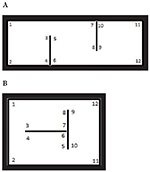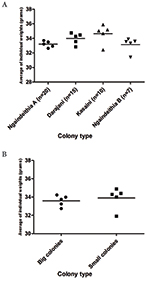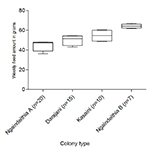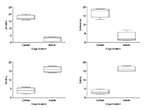Original scientific article
Housing behaviour of the naked mole rat (Heterocephalus glaber) under
laboratory conditions
by Royford Mwobobia1,2; Klas Abelson1; Titus Kanui2
1Department of Experimental Medicine, Faculty of Health and Medical
Sciences, University of Copenhagen, Blegdamvej 3B, 2200 Copenhagen,
Denmark
2School of Agriculture and Veterinary Sciences, South Eastern Kenya
University
P O Box 170-90200, Kitui, Kenya
 Correspondence: Mwobobia R.M
Correspondence: Mwobobia R.M
School of Agriculture and Veterinary Sciences, South Eastern Kenya
University
P O Box 170-90200, Kitui, Kenya
mmurangiri@gmail.com
Summary
The naked mole rat (Heterocephalus glaber) is a rodent that
has gained importance as a biomedical research model for various
conditions including hypoxic brain injury, cancer and nociception. It
is captured from the wild and housed under laboratory conditions
during research. Much is unknown about how to optimize housing
conditions for the animals in captivity. This study was designed to
establish whether the animals will replicate in the laboratory their
natural behaviour of having separate resting, waste disposal and
eating areas. A total of 52 naked mole rats were kept in four colonies
of different sizes and housed in two types of cage design. It was
found that, in all four colonies, their behavior was similar to that
in the wild with regards to separating their resting, eating,
defecation and urination areas. Urination and defecation commonly
occurred in the outer corners of the cages while resting and eating
mostly occurred in the inner parts of the cages. Average daily feed
consumption was 7.6 grams per naked mole rat. Weekly weight gain
averaged 0.44 grams per naked mole rat. In this study, the four
colonies of naked mole rats behaved similarly in their selection of
resting, waste disposal and eating area. However, additional studies
are needed to investigate further whether these behaviours can be
affected by colony origin, colony size or cage size. The results of
our study indicate that resting,
eating and waste disposal behaviours need to be taken into
consideration when housing naked mole rats, to optimize the comfort of
these animals in captivity.
Introduction
The naked mole rat (Heterocephalus glaber) is a subterranean rodent belonging to the family Bathyergidae. They are found in semi-arid regions of East Africa, mainly in Somalia, Kenya and Ethiopia. They are eusocial (Schumacher et al. 2015; Jarvis 1981), living in colonies of up to 300 animals of overlapping generations who collectively care for the young and, in addition, show division of labour (Jarvis 1981; Susan et al. 2012).
Naked mole rats are gaining in importance for biomedical research,
being used as animal models for studies of neurodegenerative diseases,
aging, cancer, nociception, hypoxia and bioprospecting. They are
hypoxia-tolerant at the neuronal level, insensitive to acid-induced
pain and acidic fumes, are cancer resistant and long lived. These
characteristics make naked mole rats unique compared to laboratory
mice and rats (Clarke and Faulkes 1998; Kim et al. 2011; Schumacher et
al. 2015; Abiyselassie 2018). Naked mole rats housed in laboratory
conditions are shown in Figure 1, and their biological characteristics
and some environmental requirements are listed in Table 1.
Despite the use of naked mole rats in laboratory experiments, there is
still a lack of knowledge about optimal housing methods in captivity.
To create a good laboratory environment for this species, it is
necessary to study their behaviour under laboratory conditions in
relation to their behaviour in the wild. This will allow optimization
of their housing conditions, to assure well-being and correct handling
of this species, as well as the quality of the research.
Studies indicate that, in the wild, naked mole rats have separate
areas in their tunnels for resting, eating, urination and defecation
(Jarvis and Sherman 2002). This study was designed to find whether
these animals would replicate this behaviour under laboratory
conditions and if the size of the colony or cage affects this
behaviour.
|
Figure 1. Naked mole rats housed at the South
Eastern Kenya University. Click image to enlarge |
Table 1. Biology and environmental requirements of naked mole rats.
| Characteristic |
Description |
References |
Behaviour |
Eusocial rodent that lives in colonies of up to 300 animals of mixed generations |
Kress et al. 2017; Schuhmacher et al. 2015 |
Breeding |
Colony composed of a single breeding female, one to three breeding males and other hormonally suppressed colony members |
Clarke and Faulkes 1998; |
Gestation |
66-74 days |
Abiyselassie 2018 |
Litter size |
Mean litter size of 12 pups |
Buffenstein 2005 |
Body |
Cylindrical body measuring 8-10 cm long and a tail 3-5cm long |
Jarvis and Sherman 2002; Abiyselassie 2018 |
Adult weight |
30-50 grams |
Jarvis and Sherman 2002 |
Body temperature |
32°C and poikilothermic |
Schuhmacher et al. 2015 |
Longevity |
Up to 32 years |
Kim et al. 2011 |
Diet |
Roots and tubers |
Abiyselassie 2018 |
Drinking |
They solely obtain water requirements from succulent food they consume |
Jarvis and Sherman 2002 |
Habitat |
Subterranean in underground tunnels that extend up to 3 kilometres depending on food availability and colony size |
Schuhmacher et al. 2015 |
Tunnel humidity |
Up to 90% |
Schuhmacher et al. 2015 |
Tunnel temperature |
28-32°C |
Abiyselassie 2018 |
Materials & Methods
Ethical statement
The experiments were conducted after licensing (KWS/BRM/5001), and
obtaining a permit (KWS/904) to capture naked mole rats, by the Kenya
Wildlife Service (KWS) which licenses all research on wildlife in
Kenya. The study also adhered to the prevention of cruelty to animals
act, chapter 360, laws of Kenya (2012), and directive 2010/63/EU of
the European Parliament and of the Council on the protection of
animals used for scientific purposes (European Union 2010).
Animals, housing and experimental design
The experiment was undertaken at the South Eastern Kenya University.
A total of 52 naked mole rats were used in the study. They were
captured from their natural burrows in Makueni County, Kenya, while
they were digging fresh mole hills (see Figure 2). Animals weighing
above 18 grams were chosen for the experiment and smaller individuals
were immediately returned to their burrows.
|
Figure 2. Mole hills at Ngaindeithia village,
Makueni County, Kenya. The mole hills are created by naked mole
rats pushing soil onto the surface while digging tunnels
underground. Click image to enlarge |
Four colonies were established for the study. The study colonies were
named according to their site of origin: Ngaindeithia A, Ngaindeithia
B, Kasaini and Darajani. Each colony was housed separately in one cage
which was also an experimental unit. Each colony was composed of naked
mole rats of both sexes in different proportions. Body weights at the
beginning of the experiment ranged between 18-41 grams, but the ages
of the animals were unknown. All animals were marked for
identification by drawing numbers on their backs using a marker pen.
Two cage sizes were built to study the effect of cage size and the
colony density on behaviour: Type 1 with 120 cm length x 40 cm width x
30 cm height (Figures 3 and 6A) and Type 2 with 70 cm length x 50 cm
width x 20 cm height (Figures 4 and 6B). Cages were made of 3 mm
diameter clear plastic acyclic glass (perspex) and they were covered
with pieces of plywood with holes to allow for ventilation.
|
Figure 3. Cage Type 1: 120 cm length x 40 cm
width x 30 cm height, the floor area was 4800 cm2. The cage was
divided into three compartments. Click image to enlarge |
|
Figure 4. N Cage Type 2: 70 cm length x 50 cm
width x 20 cm height, the floor area was 3500 cm2. The cage was
divided into three compartments. Click image to enlarge |
Table 2. Colony housing details
| Colony |
Ngaindeithia A |
Darajani |
Kasaini |
Ngaindeithia B |
Animal number in colony |
20 |
15 |
10 |
7 |
Cage type |
1 (4800 cm2) |
1 (4800 cm2) |
2 (3500 cm2) |
2 (3500 cm2) |
Space/animal |
240 cm2 |
320 cm2 |
350 cm2 |
500 cm2 |
|
Total weight of the colony at the beginning |
652.6 g |
492.7 g |
324.2 g |
219.8 g |
|
The mean weights of animal at the beginning |
32.63 ± 4,4 g |
32.85 ± 5,9 g |
32.42 ± 6,0 g |
31.40 ± 5,7 g |
The cages were divided by partitions into three compartments to simulate the natural habitat and the tunnel structures of the naked mole rats, giving them opportunity to use separate areas for different behaviours. The partitions are shown in Figures 3 and 4 and indicated by lines in Figures 6A and 6B. The partitions and outer sides of the cages were opaque during the experiments; the cage in Figure 4 was covered on the outer side with opaque material during experimentation period. This was to mimic an underground burrow with solid earthen walls.
The four colonies had a different number of naked mole rats. Colonies
Ngaindeithia A (n=20) and Darajani (n=15) were housed in Cage Type 1
and Kasaini (n=10) and Ngaindeithia B (n=7) in Cage Type 2. The floor
area per individual animal and the total weight of the colony at the
beginning of the experiment are shown in Table 2.
The cage bedding consisted of wood shavings of fine texture made from
local trees; was not pre-treated with any chemicals and was changed
weekly. The cage bedding was about 2.5 cm deep. No additional
materials were provided in the cage.
Temperature in the animal room was maintained at 28-31°C, to simulate
the temperature in the animals’ natural burrows. Humidity was
maintained at 50-70% to prevent drying and scaling of the mole rat
skin. Both temperature and humidity in the room were measured by a
thermo hygrometer (Brannan, England). Room temperature was maintained
by the use of two 250 watt infrared lamps (Euro-matt) and a fan heater
(1500 watts, Intertronic, UK). By blowing hot air, the fan heater
assisted evaporation of water from plastic basins, thus raising
humidity levels.
The light-dark cycle in the animal room was 12/12, with lights on from
06.00 to 18.00 hours. Ventilation of the cages was achieved by
covering them with plywood that had 3 holes each of 2 cm diameter
(each aligned per cage compartment) to allow circulation of air. The
plywood cover was also not closely fitting. The animal room with cages
and other equipment is shown in the Figure 5.
|
Figure 5. The animal room showing placement of
various items: the four naked mole rat colonies (c1-c4),
infrared lamps (IR), thermo hygrometer (T), fan heater (FH),
water basins (WB). Click image to enlarge |
Feeding and food consumption
Animals were provided with food chopped into pieces of about 1 cm,
which made it necessary for the animals to spend time chewing the
food. Enough food was provided to allow ad libitum consumption such
that there was always uneaten food remaining the following day. Since
each cage had three compartments, food was placed in the middle of
each compartment sequentially during the experimental period. The diet
consisted of fresh carrots, sweet potatoes and Irish potatoes. There
was no pre-treatment of the food except for washing in clean water.
Animals were fed daily at around 09.00 am after measuring food
remaining from the previous day and observing their behaviour. No
water was provided since the animals obtain their water requirements
from their succulent diet (Jarvis and Sherman 2002).
To calculate the food consumed in each cage, the remaining food was
subtracted from the food provided, taking a factor for environmental
moisture loss into consideration, i.e. the food consumed was
calculated as amount fed - remaining food - environmental moisture
loss. Environmental moisture loss was averaged at 22.2% and was
calculated by leaving a known amount of food undisturbed in the same
room with naked mole rats and weighing it again after 24 hours. The
loss in weight was attributed to moisture loss to the environment.
Food consumption was investigated for 28 days.
|
Figure 6. Cage type 1 (A) and cage type 2 (B)
seen from aerial view. The lines inside both cage types are
partitions dividing the cages into three compartments. Numbers
1-12 in each cage show the points where behavioural observations
were made, i.e. urination, defecation, eating and resting
behaviours. The points were classified as either outer corners
(points 1, 2, 11 and 12) or inner areas (points 3-10). Click image to enlarge |
Statistical analysis
Food consumption data were analysed using one way ANOVA with Tukey’s
multiple comparison tests. Weight gain among the four colonies was
analysed using one way ANOVA tests while the t-test was used to
compare weight gain between large and small colonies. Both ANOVA and
t-test were carried out using Graph Pad Prism 5.0. Chi-square test was
used to analyse behavioural observations.
Results
Naked mole rat weights
Weekly weight gain averaged 0.44 g per animal. The iincrease in total
animal weight per colony from the beginning to the end of the
experiment was 34.7 g (Kasaini), 28.5 g (Darajani), 21.4 g
(Ngaindeithia A) and 17.4 g (Ngaindeithia B). Kasaini colony had the
highest (median and mean) weight gain while Ngaindeithia A colony had
the lowest (median and mean) weight gain as well as the smallest
variation in weights (Figure 7A). However, there was no significant
difference in weight gain between the four colonies and there was no
significant difference in weight gain between small and large colonies
(Figure 7B).
|
Figure 7. Scatter plots at each colony
represents means of individual animal weight at days 1, 7, 14,
21 and 28. Horizontal bars on the scatter plots represent
overall mean of the individual weights for the entire
experimental period. Figure 7A shows scatter plots of mean
individual weights for the four colonies. Figure 7B shows
scatter plots of mean individual weight for the colonies grouped
into either big colonies i.e. Darajani (n=15) and Ngaindeithia A
(n=20) or small colonies i.e. Kasaini (n=10) and Ngaindeithia B
(n=7). Click image to enlarge |
Food consumption
The average daily food consumption per naked mole rat was 7.6 grams
after factoring environmental moisture losses of 22.2% per day
(Ngaindeithia A=6.4 grams, Darajani=7.2 grams, Kasaini=7.8 grams and
Ngaindeithia B=9.1 grams). Environmental moisture loss was associated
with the animal room temperatures kept above 28°C. Weekly food
consumption per individual naked mole rat in Ngaindeithia B colony
exceeded that in other colonies. Large colonies (Ngaindeithia A and
Darajani) consumed significantly less (P < 0.05) food per week
compared to Ngaindeithia B colony (Figure 8).
|
Figure 7. Box and whisker plots showing weekly
food consumption (in grams) per naked mole rat in each of the
four colonies. The whiskers outside the boxes represent minimum
and maximum values while lines within the boxes represent median
values. Click image to enlarge |
Behavioural observations
The animals were consistent by undertaking a particular behaviour, for
example urination, around a particular site in the cage and did not
use other sites. Hence every day, each behaviour was recorded at one
site which was either an outer corner or inside area of the cage. Thus
on each day there was just one data point per behaviour per colony.
Urination and defecation occurred mostly at the outer corners (points
1, 2, 11 and 12) while resting and eating occurred predominantly at
the inner areas (points 3-10) of the cages (See Figures 6 A and B).
Although the Darajani colony had more defecation recorded at the inner
areas of the cage than the other colonies (p = 0.035, chi square
test), most defecation occurred at the outer corners. Thus, in all
colonies, the pattern of separating toilet (urination and defecation)
from eating and resting areas occurred irrespective of colony size or
cage design (Figure 9).
|
Figure 9. Box and whisker plots showing the
location of the toilet, eating and resting behaviours,
classified as either outer corners of the cages (points 1, 2, 11
and 12) or inside areas of the cages (points 3 to 10). For all
colonies, each behaviour was counted once a day for 20 days. The
number of times a behaviour was recorded on the inner or outer
areas is shown on the vertical axis. The whiskers outside the
boxes show minimum and maximum counts for the particular
behaviour while lines within the boxes show the medians. Click image to enlarge |
Discussion and conclusion
The European Union directive 2010/63 (European Union 2010), emphasizes refinement of accommodation and care of laboratory animals to reduce animal suffering and distress. The directive also advises on accommodation and care of animals based on specific needs and characteristics of each species. Similar emphasis is expressed in the FELASA (Federation of European Laboratory Animal Science Associations) report on provision of environmental enrichments through complexity, resting and bedding facilities to allow for species specific behaviours and reduce experimental variability (FELASA 2006).
This study was designed to find out whether captive naked mole rats
can replicate in the laboratory their natural behaviour in the wild of
having separate resting, waste disposal and eating areas.The animals
were housed at a room temperature between 28 to 31oC and humidity of
50-70%. They were kept in ventilated cages with three compartments and
provided with fine wood shavings for bedding and resting, and food
consisting of fresh carrots and potatoes. These conditions were
designed to simulate the environmental conditions in nature as
reported by Schumacher et al. (2015) where they live in an underground
network of chambers and tunnels, with temperatures ranging between 28
to 32oC depending on tunnel depth, high humidity levels of up to 90%,
and feed on roots and tubers.
In the laboratory, all four naked mole rat colonies had eating and
resting areas separated from waste disposal areas (defecation and
urination). Resting and eating sites were found to be at the same
place or adjacent to each other, but separate from urination and
defecation sites, which were also at the same place or adjacent to
each other. This behaviour reflects that seen in the wild, where naked
mole rats are reported to urinate and defecate only in the toilet
chamber to avoid contamination. In addition, the animals dig new sites
for urination and defecation if the old ones become full (Jarvis and
Sherman 2002; Rosamond Gifford Zoo 2006). A study by Margullis et al.
(1995) observed the same behaviour in captive naked mole rats which
also separated eating sites from urination and defecation sites.
The observation that naked mole rats in small colonies consumed more
food but without a significant difference in weight gain compared to
the naked mole rats in large colonies indicates they may have been
more active and therefore expended more energy. The finding that there
was no significant difference in weight gain between the four
colonies, suggests that the number of naked mole rats per cage may not
influence weight gain. During the experiment, the naked mole rats were
fed on a diet of fresh sweet potatoes, carrots and Irish potatoes. The
observed weekly weight gain of 0.44 g per naked mole rat indicates
this diet is suitable for use in the laboratory. In both wild and
captive conditions, they feed on roots, tubers and bulbs such as sweet
potatoes, Irish potatoes, grapes, apples, bananas and other succulent
plant material (Rosamond Gifford Zoo 2006; Judd and Sherman 1996;
Jarvis and Sherman 2002). The animals also practice coprophagy to
maximize extraction of nutrients from their food (Abiyselassie 2018).
Since there is a lack of data on standard housing of the naked mole
rat under laboratory conditions, the findings of this study provide an
initial recommendation of how to house the naked mole rat. These
findings are open for further improvement, but already fulfil the
intentions of EU directive 2010/63 (European Union 2010).
Based on this study, it is recommended that captive naked mole rats
should be provided with cages designed to allow them to maintain
separate locations for waste disposal (urination and defecation),
resting and eating. This is an important consideration to increase
comfort and well-being of these animals in the laboratory. However,
additional studies are needed to investigate further the effect of
colony size, colony origin and cage size on naked mole rats’ behaviour
in captivity.
Acknowledgements
The authors would like to thank the University of Copenhagen for
providing grants to facilitate the completion of the study, as well as
the South Eastern Kenya University for providing the research
infrastructure needed. The authors would also like to express
gratitude to Gilbert Mwanthi for taking care of the animals.
The authors received generous assistance in data analysis by Dr. Gerit
Pfuhl, UiT The Arctic University of Norway.
Conflict of interest
The authors declared no potential conflict of interest.
References
- Abiyselassie, G.A., (2018). Overview of African naked mole-rat Heterocephalus glaber for bioprospecting and access and benefit sharing in Ethiopia. GSC Biological and Pharmaceutical Sciences. 4(1), 25-37. doi:10.30574/gscbps.2018.4.1.0042
- Buffenstein, R., (2005). The naked mole-rat: A new long-living model for human aging research. Journal of Gerontology: Biological Sciences. 60(11), 1369–1377.
- Clarke, F.M., Faulkes, C.G. (1998). Hormonal and behavioural correlates of male dominance and reproductive status in captive colonies of the naked mole-rat, Heterocephalus glaber. Proceedings. Biological sciences. 265(1404), 1391–1399. https://doi.org/10.1098/rspb.1998.0447
- European Union, (2010). Directive 2010/63/EU of the European Parliament and of the Council of 22 September 2010 on the protection of animals used for scientific purposes. Official Journal of the European Union L276/33. https://eur-lex.europa.eu/LexUriServ/LexUriServ.do?uri=OJ:L:2010:276:0033:0079:EN:PDF
- FELASA Standardization of Enrichment Working Group Report, (2006) http://www.felasa.eu/working-groups/reports/standardization-of-enrichment/
- Imberman, S.P., Kress, M., McCloskey, D.P., (2012). Using Frequent Pattern Mining to Identify Behaviors in a Naked Mole Rat Colony. Proceedings of the Twenty-Fifth International Florida Artificial Intelligence Research Society Conference.
- Jarvis, J.U.M., (1981). Eusociality in a mammal: Cooperative breeding in naked mole-rat colonies. Science. 212(4494), 571-573.
- Jarvis, J.U.M., Sherman, P.W., (2002). Heterocephalus glaber. Mammalian Species. (706), 1–9.
- Judd, M., Sherman, W., (1996). Naked mole-rats recruit colony mates to food sources. Animal Behaviour. (52), 957–969.
- Kim, E.B. et al., (2011). Genome sequencing reveals insights into physiology and longevity of the naked mole rat. Nature. (479), 223. doi:10.1038/nature10533
- Kress, M., Meehan, E.F., McCloskey, D., (2017). Large-scale surveillance of captive naked mole-rat colonies shows caste differences in space utilization. Working Paper. CUNY Academic Works. https://academicworks.cuny.edu/si_pubs/102/.
- Margullis, S.W., Saltzman, W., Abborrt, D.H., (1995). Behavioral and hormonal changes in female naked mole-rats. Hormones and behaviour. (29), 227-247.
- Prevention of cruelty to animals act, Chapter 360, laws of Kenya, Revised edition 2012 [1983] http://extwprlegs1.fao.org/docs/pdf/ken63702.pdf
- Rosamond Gifford Zoo (2006). Naked mole rat (online), Available at http://www.rosamondgiffordzoo.org/assets/uploads/animals/pdf/NakedMoleRat.pdf
-
Schumacher, L., Husson, Z., Smith, E.S., (2015). The naked mole-rat
as an animal model in biomedical research: current perspectives.
Open Access Animal Physiology. (7), 137–148.
https://doi.org/10.2147/OAAP.S50376









